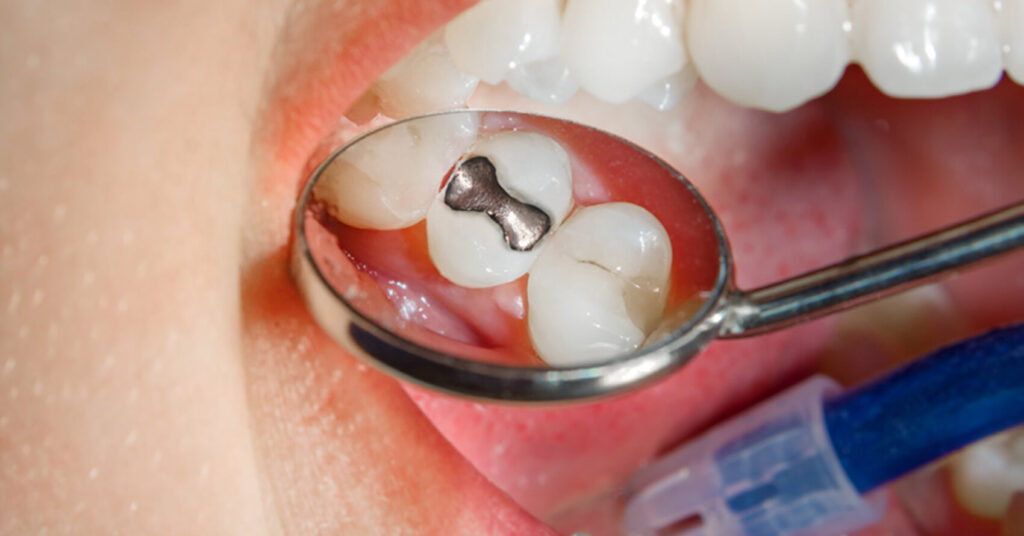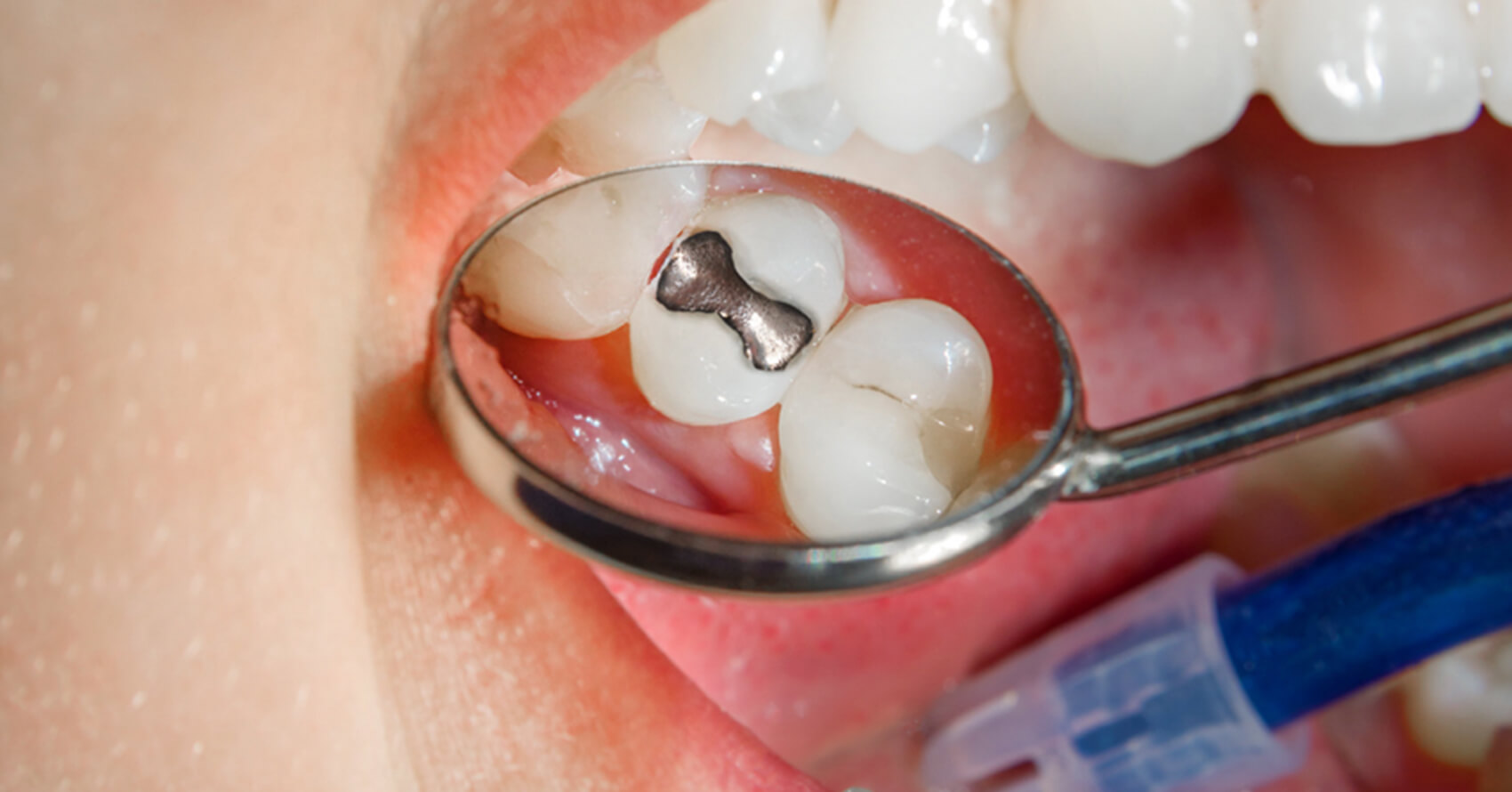
Nothing lasts forever, and that includes the fillings in your teeth. You can expect traditional amalgam (silver) fillings to last anywhere from 10 to 15 years while tooth-colored composite fillings last less than that. That is why regular dental exams are important so that your dentist can repair or replace fillings as needed.
But what should you do if you suddenly lose a filling? Most of the time a lost filling isn’t considered a dental emergency, but you still need to get your tooth looked at and there are certain things you can do for damage control until you’re in the dental chair. Here’s what you should do if you’ve discovered your tooth filling fell out.
My Filling Fell Out—Now What?
So, you’re enjoying a meal when you bite down, feel something come loose in your mouth, and then notice when you look in the mirror or probe around with your tongue that one of your teeth now has a hole in it where a filing used to be.
If you didn’t swallow the filling, rinse it off and place it in a plastic bag. Your dentist may or may not reuse it, but sometimes it’s helpful to show it to them.
Contact your dentist to make an appointment, even if you’re not experiencing any pain. In the meantime, you’ll want to protect the tooth because it’s now vulnerable to breakage and decay.
Continue to brush your teeth, as usual, using a soft-bristled toothbrush and fluoride toothpaste. Be gentle, because if the filling was large or close to the nerve you may feel pain or sensitivity. If you do have pain you can place a few drops of clove oil onto a cotton swab and gently apply it to the cavity to help dull the nerves.
Then make a trip to the drugstore and pick up an over-the-counter temporary dental cement product in the dental care section. Follow the directions on the box. You’ll most likely have to rinse the tooth with the cavity with a warm salt water rinse and let the hole stay wet to apply the dental cement.
Most over-the-counter dental cement products set in a couple of hours, allowing you to eat as you normally would. You’ll want to place the product into the cavity, bite down, and remove any excess product. Some brands provide you with a tool to help pack and shape the cement into the tooth.
Keep in mind that these products are meant for temporary use only until you can see a dentist. You definitely shouldn’t rely on them as a permanent solution to avoid a dental visit.
You should still take care when eating and chewing and avoid biting down on anything that’s very hard. If you’re experiencing pain, you’ll want to see your dentist right away. In the meantime, take ibuprofen which helps minimize swelling and apply a cold compress to the outside of your cheek to help ease the discomfort.
But My Tooth Doesn’t Hurt. Why Do I Need the Filling Replaced?
You may be tempted to put off seeing the dentist if your tooth that lost the filling isn’t bothering you. But this is a risky idea that can lead to pain and more extensive dental services down the road. One problem with waiting too long to have a dentist replace a lost filling is that the tooth is now weakened and a lot easier to break.
Fillings, crowns, and other dental work help restore a tooth after part of it has been removed because of decay. Without the filling, it’s a lot more delicate and can break more easily. This will lead to additional dental work or worse, you could end up losing the tooth.
Another reason why you don’t want to avoid the dentist after losing a filling is that it’s a lot easier for decay to form inside the hole. A tooth’s inner structure is softer than the hard enamel coating and can decay rather quickly. And it may be difficult to reach and brush away bacteria in the hole using a toothbrush.
If a new cavity forms in the tooth, the decay can spread quickly to the pulp which is the area of the tooth that contains the nerves and blood supply. When this happens, you’ll develop a toothache, infection, and potentially an abscessed tooth. A dentist will need to perform a root canal to save the tooth and stop the pain and infection. If the decay spreads too much, the tooth will have to be extracted.
Also, even if your tooth doesn’t hurt after losing a filling, it could start to cause pain a few days later if the filling was large or close to the nerve. Needless to say, you should make an appointment to see a dentist soon after losing a filling. Chances are, if the dentist finds no new decay in the tooth or any other problem that has to be treated, they can place a new filling without even having to give you local anesthesia.
What Causes a Filling to Fall Out?
There are a few different reasons why fillings may fall out. One common reason is secondary decay that formed underneath the filling, causing it to come loose.
When a filling gets old it can pull away from the edges of a tooth, allowing bacteria to seep into the cavity again. This bacteria is often impossible to brush away with a toothbrush and toothpaste.
The tooth may also have been damaged by a chip or crack. You may have bitten down on something hard that compromised it and damaged the filling.
Old fillings can also become loose over time. Amalgam fillings contract and expand with exposure to hot and cold foods and beverages. After so many repeated expansions and contractions they can begin to damage a tooth or fall out if they’re not replaced in a timely manner.
How a Dentist Replaces a Filling
Your dentist will assess your tooth’s condition and make sure it wasn’t further damaged since the filling fell out. If you have a temporary dental cement product in your tooth, they’ll gently remove it.
Your dentist will check the tooth for any decay and remove it before placing a new filling. They may also need to perform a root canal if the pulp area is close to being exposed. If the tooth has a crack or chip that can be repaired, they’ll take care of that as well.
You may or may not need local anesthesia. If there’s no repair work needed on the tooth, they can usually just go ahead and replace the filling. You may receive the original type of filling or another kind if you have a preference or if your dentist thinks one will work better than the other.
Either way, having a filling replaced is a pretty standard dental procedure that any family dental practice such as http://www.boisedentist.com/ can perform. It also doesn’t hurt.
How to Prevent a Lost Filling
Sometimes losing a filling is unavoidable, but there are a few things you can do to lengthen the longevity of your dental work.
First, visit your dentist every six months for a check-up. They don’t just check your teeth for cavities; they also examine the condition of your current work to make sure it’s still holding up well. A dentist can detect a loose or leaking filling and replace it before it can fall out, develop decay, or cause other problems.
Avoid biting down on extremely hard foods such as ice cubes, hard candy, or wayward unpopped popcorn kernels in your popcorn. They can damage fillings as well as cause cracks and chips in your teeth.
Care for your teeth properly by brushing and flossing them daily and avoiding excess sugar in the food you eat and beverages you drink. Try to limit your intake of sugary and sticky foods to help prevent cavities. Preventing the need for a lot of fillings in the first place will help you avoid losing one.
Try to avoid grinding your teeth, which can cause chips and cracks to form over time. You may be clenching your jaw and grinding your teeth in your sleep. Your dentist will be able to tell and can provide you with a nightguard to wear while sleeping to help protect your teeth.
If anything ever feels off in your mouth in between your regular dental check-ups, be sure to make an appointment so your dentist can check it out.
Don’t Panic Over a Lost Filling
If your filling fell out, follow these tips so you can get back to eating and enjoying life without worrying about your tooth. Above all, don’t panic: a lost filling can be fixed as long as you see your dentist soon.
For more advice on keeping your smile strong and healthy, check out our posts in our Health Tips section.
